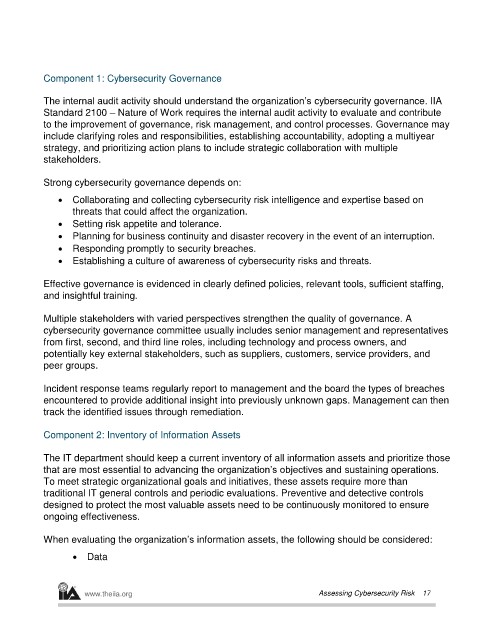Page 321 - ITGC_Audit Guides
P. 321
Component 1: Cybersecurity Governance
The internal audit activity should understand the organization’s cybersecurity governance. IIA
Standard 2100 – Nature of Work requires the internal audit activity to evaluate and contribute
to the improvement of governance, risk management, and control processes. Governance may
include clarifying roles and responsibilities, establishing accountability, adopting a multiyear
strategy, and prioritizing action plans to include strategic collaboration with multiple
stakeholders.
Strong cybersecurity governance depends on:
Collaborating and collecting cybersecurity risk intelligence and expertise based on
threats that could affect the organization.
Setting risk appetite and tolerance.
Planning for business continuity and disaster recovery in the event of an interruption.
Responding promptly to security breaches.
Establishing a culture of awareness of cybersecurity risks and threats.
Effective governance is evidenced in clearly defined policies, relevant tools, sufficient staffing,
and insightful training.
Multiple stakeholders with varied perspectives strengthen the quality of governance. A
cybersecurity governance committee usually includes senior management and representatives
from first, second, and third line roles, including technology and process owners, and
potentially key external stakeholders, such as suppliers, customers, service providers, and
peer groups.
Incident response teams regularly report to management and the board the types of breaches
encountered to provide additional insight into previously unknown gaps. Management can then
track the identified issues through remediation.
Component 2: Inventory of Information Assets
The IT department should keep a current inventory of all information assets and prioritize those
that are most essential to advancing the organization’s objectives and sustaining operations.
To meet strategic organizational goals and initiatives, these assets require more than
traditional IT general controls and periodic evaluations. Preventive and detective controls
designed to protect the most valuable assets need to be continuously monitored to ensure
ongoing effectiveness.
When evaluating the organization’s information assets, the following should be considered:
Data
www.theiia.org Assessing Cybersecurity Risk 17

